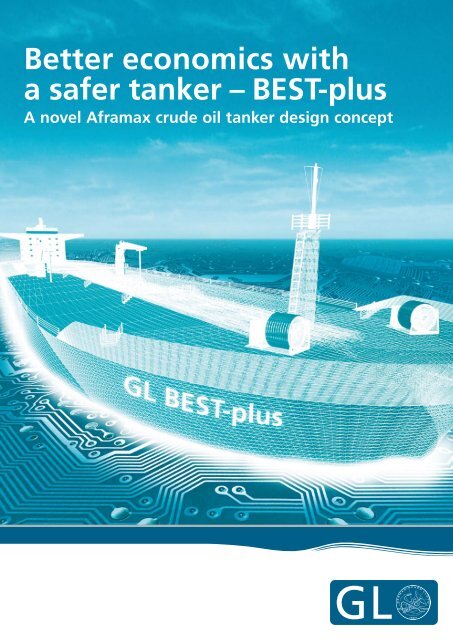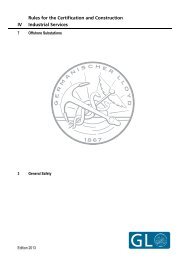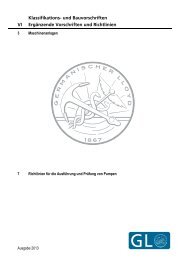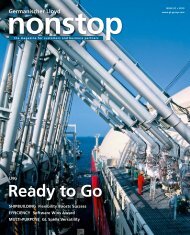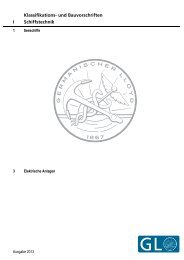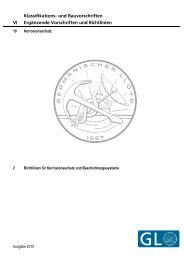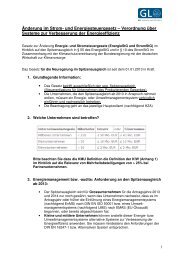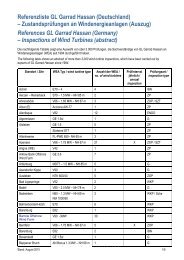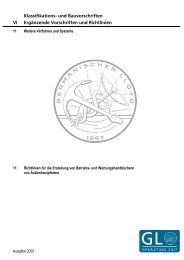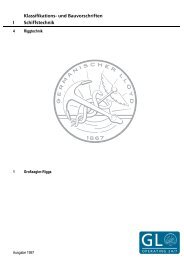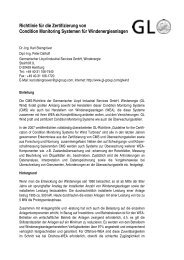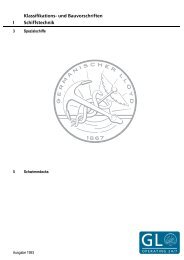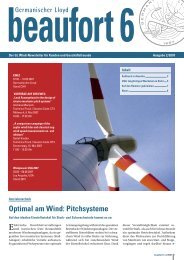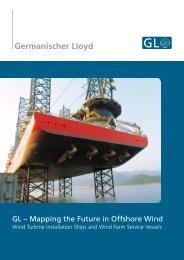A novel Aframax oil tanker design concept - GL Group
A novel Aframax oil tanker design concept - GL Group
A novel Aframax oil tanker design concept - GL Group
Create successful ePaper yourself
Turn your PDF publications into a flip-book with our unique Google optimized e-Paper software.
Better economics with<br />
a safer <strong>tanker</strong> – BEST-plus<br />
A <strong>novel</strong> <strong>Aframax</strong> crude <strong>oil</strong> <strong>tanker</strong> <strong>design</strong> <strong>concept</strong>
Background and motivation<br />
Oil <strong>tanker</strong> safety has improved over the last decades and this<br />
has been documented in a recent Formal Safety Assessment<br />
(FSA) study for large <strong>oil</strong> <strong>tanker</strong>s submitted to the IMO.<br />
The risk picture for modern <strong>oil</strong> <strong>tanker</strong>s shows that the risk to<br />
the environment is dominated by collision, grounding and fire.<br />
The FSA study suggested considering larger double hull<br />
widths and double bottom heights as potential cost-effective<br />
risk control options.<br />
tonnes per ship year<br />
24<br />
20<br />
16<br />
12<br />
8<br />
4<br />
0<br />
Potential loss of cargo from <strong>oil</strong> <strong>tanker</strong>s<br />
collision contact grounding fire explosion NASF*<br />
(Source: MEPC 58/17/2)<br />
Since the introduction of the double hull <strong>concept</strong>, <strong>oil</strong> <strong>tanker</strong><br />
<strong>design</strong> has not evolved, and changes have recently been<br />
driven primarily by improving production at the ship yards. Little<br />
attention has been paid to the product’s performance over the<br />
lifecycle and, in particular, the fuel-efficiency – as measured by<br />
the EEDI – has not improved in the last 20 years, despite the<br />
general improvement in systems and their efficiency.<br />
The recently developed Energy Efficiency Design Index (EEDI),<br />
which is planned as a future mandatory newbuilding standard,<br />
is a simple but accurate measure of a vessel’s inherent fuelefficiency,<br />
which compares CO 2 -emissions to transport work.<br />
Although <strong>oil</strong> <strong>tanker</strong>s are considered to be among the most<br />
energy efficient vessels today, with an EEDI value ranging from<br />
2 to 6 g CO 2 / (t*nm), they emitted approximately 115 million<br />
tonnes of CO 2 in 2009, which is an 8% increase compared to<br />
2007. The current share of <strong>oil</strong> <strong>tanker</strong> CO 2 emissions is<br />
approximately 12% of the total CO 2 emissions from inter-<br />
national shipping.<br />
average EEDI<br />
(g CO2 / t*nm)<br />
10<br />
9<br />
8<br />
7<br />
6<br />
5<br />
4<br />
3<br />
2<br />
1<br />
0<br />
1980<br />
Crude <strong>oil</strong> <strong>tanker</strong>s (delivered / on order)<br />
1985 1990 1995 2000 2005 2010<br />
Source: IHS database, 2011<br />
In response, <strong>GL</strong> and the National Technical University of Athens<br />
(NTUA) teamed up in 2008 to develop a <strong>novel</strong> <strong>Aframax</strong> <strong>tanker</strong><br />
<strong>design</strong> <strong>concept</strong>, which won the Lloyd’s List Greek Shipping<br />
Award for technical achievement in 2009. <strong>GL</strong> also received<br />
feedback from shipyards and <strong>oil</strong> <strong>tanker</strong> operators regarding<br />
the desired features of new <strong>tanker</strong> <strong>design</strong>s, and these were<br />
incorporated in the new <strong>design</strong> <strong>concept</strong> called BEST-plus.<br />
BEST-plus enhances the attractiveness of the initial <strong>design</strong><br />
<strong>concept</strong> by also integrating hydrodynamic optimisation of the<br />
hull form and, thus, reducing fuel consumption and emissions.<br />
<strong>GL</strong> and NTUA again cooperated on the new <strong>design</strong> <strong>concept</strong>, and<br />
were supported by FRIENDSHIP SYSTEMS – a <strong>GL</strong> company<br />
and provider of the FRIENDSHIP- Framework Computer Aided<br />
Design (CAD) and Computational Fluid Dynamics (CFD)<br />
integration platform.
Market analysis and <strong>design</strong> scenario<br />
Based on current growth rates, <strong>oil</strong> transport demand is expected<br />
to be lower than available <strong>oil</strong> <strong>tanker</strong> supply for the next couple<br />
of years. However, even small changes in demand will open up<br />
opportunities for new <strong>Aframax</strong> <strong>tanker</strong>s starting in 2014. This<br />
was recently documented by the International Association of<br />
Independent Tanker Owners (INTERTANKO). A second analysis<br />
based on Fairplay data shows that approximately 20% of<br />
existing <strong>Aframax</strong> tonnage will be older than 15 years in 2012, and<br />
this could trigger replacement activities. The <strong>novel</strong> BEST-plus<br />
<strong>design</strong> <strong>concept</strong> anticipates this possible demand for new <strong>tanker</strong><br />
tonnage by integrating only available technologies.<br />
m dw1<br />
20<br />
16<br />
12<br />
8<br />
4<br />
0<br />
-4<br />
no. of<br />
vessels<br />
80<br />
70<br />
60<br />
50<br />
40<br />
30<br />
20<br />
10<br />
<strong>Aframax</strong> phase-out, deliveries, scrapping<br />
Assumed marketbalance end 2008<br />
<strong>Aframax</strong> crude <strong>oil</strong> <strong>tanker</strong> fleet projection for 2013-01-01<br />
Max phase out<br />
Deletions<br />
Deliveries<br />
Increase in demand:<br />
Surplus 0%<br />
Surplus 2.5%<br />
Surplus 4%<br />
Surplus 7.5%<br />
2 3 4 5 6 7 8 9 10 11 12 13 14 15<br />
year<br />
(Source: Intertanko weekly news, no. 42, 22 October 2010)<br />
0<br />
3 5 7 9<br />
vessels age (years)<br />
11 13 15<br />
The <strong>novel</strong> <strong>design</strong> <strong>concept</strong> targets the typical <strong>Aframax</strong> <strong>oil</strong> <strong>tanker</strong><br />
trades in the Caribbean Sea. Facilities in the main US ports<br />
and the US Emission Control Area (ECA) set the operating<br />
conditions. If a Mexican ECA would be implemented as well,<br />
approximately 30% of the total transit distance for this trade<br />
would be inside of an ECA. The current <strong>design</strong> assumes the<br />
use of MGO as fuel when sailing in an ECA. LNG as ship fuel,<br />
or the use of scrubbers, are considered as alternatives to the<br />
basic <strong>design</strong> <strong>concept</strong>.<br />
The need for relatively high speed, which has been mentioned<br />
by ship operators active in this trade, must be considered with<br />
regard to the upcoming EEDI requirement to ensure superior<br />
competitiveness of the vessel.<br />
Possible future:<br />
Mexican ECA<br />
US ECA<br />
Aruba<br />
Maracaibo<br />
St. Eustacius<br />
(transhipment)<br />
Design targets – safer, greener, smarter<br />
The <strong>design</strong> <strong>concept</strong> addresses the need for safer shipping by<br />
reducing the <strong>oil</strong> outflow in case of an accident. It contributes<br />
to greener shipping by improving energy efficiency and, thus,<br />
reducing CO 2 emissions per unit transport. In addition, the<br />
<strong>design</strong> offers smarter shipping by reducing fuel costs with an<br />
optimized hull form, and by increasing revenues with greater<br />
cargo capacity.
Design approach<br />
The <strong>design</strong> approach used an advanced optimisation environ-<br />
ment, which integrates tools to predict required propulsion<br />
power, stability, <strong>oil</strong> outflow index, cargo capacity and hull<br />
structural scantlings according to IACS CSR. This was achieved<br />
through the linking of the FRIENDSHIP-Framework with<br />
SHIPFLOW, NAPA and POSEIDON, and by using parametric<br />
models for the hull form, layout and structure, respectively.<br />
Hydrodynamic assessment<br />
with SHIPFLOW<br />
Structural assessment with<br />
POSEIDON-CSR<br />
create parametic <strong>design</strong><br />
(hull form, layout, structure)<br />
powering<br />
cargo capacity<br />
stability, <strong>oil</strong> outflow<br />
hull scantlings<br />
cost of transport<br />
Optimisation flowchart<br />
repeat for many <strong>design</strong> variants<br />
Resulting <strong>design</strong> – simply the BEST<br />
The resulting <strong>design</strong> <strong>concept</strong> features a best-in-class cargo<br />
capacity with unrivalled speed performance. The main particulars<br />
of the vessel are comparable with those of similar-sized<br />
<strong>Aframax</strong> <strong>tanker</strong>s.<br />
The optimisation targeted speed at three different drafts, a<br />
cargo capacity taking due account of cargo volume and mass,<br />
hull structural mass, cargo <strong>oil</strong> tank and ballast tank layout as<br />
well as double hull width and double bottom height, which<br />
determine the <strong>oil</strong> outflow volumes in accidents. Related <strong>design</strong><br />
parameters were systematically varied and approximately<br />
2,500 <strong>design</strong> variants were generated and assessed.<br />
104%<br />
102%<br />
100%<br />
98%<br />
96%<br />
94%<br />
92%<br />
best<br />
OOI*<br />
Normalized cost of transport<br />
reference <strong>design</strong><br />
BEST+<br />
best EEDI<br />
further local hydrodynamic<br />
optimisation<br />
110,000 112,000 114,000 116,000 DWT<br />
Cost of transport (ratio of annual capital, fuel and other operating<br />
costs to annually transported cargo mass), normalised with<br />
respect to the reference <strong>design</strong>, was used as the primary target<br />
function for the optimisation. Capital costs are based on a<br />
typical newbuilding price of 58Mio USD and 25 years lifetime.<br />
Fuel costs are computed according to a dedicated roundtrip
model (with HFO at $500/t and MGO at $800/t) for the Caribbean<br />
trade. Other operating costs are constant (approx 3Mio<br />
USD/y) and based on Moore Stephens, Opcost 2009.<br />
DWT 114,923 t<br />
Cargo volume 129,644 m 3<br />
Loa 250 m<br />
Beam 44 m<br />
Depth 21.5 m<br />
Design draft 13.7 m<br />
Cb 0.85<br />
DB height 2.1 m<br />
DBH COT 1 2.75 m<br />
DB width 2.65 m<br />
Oil outflow index 0.0142<br />
Speed at Td 15.6 kn<br />
Speed at Tb 16.8 kn<br />
EEDI 3.2814 g CO2 / (t*nm)<br />
The reference <strong>design</strong> for comparing cost of transport is an<br />
existing pre-CSR <strong>tanker</strong>, which was used as reference in our<br />
2008 study. Compared to the reference <strong>design</strong>, a 7% improvement<br />
in cost of transport was realised due to the better hull<br />
form for the best <strong>design</strong> variant. It is noted that many <strong>design</strong><br />
variants are optimal in a Pareto frontier analysis, which means<br />
that the selection of one variant for the final <strong>design</strong> depends<br />
on the weighting of the different optimisation targets.<br />
Therefore, depending upon the choice of the <strong>design</strong>er, a <strong>design</strong><br />
optimised for <strong>oil</strong>-outflow, for EEDI, or for cost-of-transport might<br />
be selected.<br />
A <strong>design</strong> for smarter shipping<br />
The resulting optimized hull form facilitates a speed of 15.6<br />
knots at <strong>design</strong> draft with a 95% confidence interval. The<br />
speed at ballast draft of 7.4m is 16.8 knots. This represents<br />
a favourable speed increase when compared with recently<br />
built vessels of the same size.<br />
P_D [kW]<br />
15<br />
14<br />
13<br />
12<br />
11<br />
10<br />
9<br />
8<br />
7<br />
Scantling draft = 14.8 m<br />
Speed / Power Curve<br />
Delivered Power P_D<br />
Design draft = 13.7 m<br />
Ballast draft = 7.4 m<br />
6<br />
13.0 13.5 14.0 14.5 15.0 15.5 16.0 16.5 Speed [kn]<br />
Ranges indicate 95% confidence intervals.<br />
With a standard main engine for <strong>Aframax</strong> <strong>oil</strong> <strong>tanker</strong>s, a MAN<br />
6S60MC-C, the fuel consumption of this vessel is comparable<br />
to similar vessels.
A <strong>design</strong> for greener shipping<br />
With this high speed and large cargo capacity, the vessel<br />
easily meets future EEDI requirements. Indeed, the attained<br />
EEDI value is merely 84% of the latest published referenceline<br />
value for this ship size. This means the vessel would be<br />
in compliance with EEDI regulations even if the first reduction<br />
to the required EEDI had already begun. At current estimates,<br />
this will happen at the earliest on the 1 st of January 2015.<br />
Although a vessel contracted before EEDI has entered into<br />
force does not formally need to comply, competitive vessels<br />
entering the market, e.g., in 2017, will be more energy-efficient<br />
and, therefore, more likely to attract cargo than older vessels<br />
with lower energy-efficiency. The new BEST-plus <strong>design</strong><br />
<strong>concept</strong> will remain highly competitive.<br />
g CO2<br />
(t*nm)<br />
4.75<br />
4.50<br />
4.25<br />
4.00<br />
3.75<br />
3.50<br />
3.25<br />
EDDI of <strong>Aframax</strong> CSR <strong>oil</strong> <strong>tanker</strong>s<br />
Attained EEDI Reference line 90% ref line 80% ref line<br />
BEST+<br />
3.00<br />
110,000 112,000 114,000 116,000 DWT<br />
A <strong>design</strong> for safer shipping<br />
(Source: data for attained EEDI from Fairplay database)<br />
To reduce <strong>oil</strong> outflow in accidents, the double hull side width<br />
was eventually set to 2.65m. In addition, to further reduce<br />
cargo tank penetration in grounding events, the inner bottom<br />
of the cargo <strong>oil</strong> tank 1 was raised from 2.10m to 2.75m. To<br />
ensure structural continuity, an inclined inner bottom is proposed<br />
between two frames. Work is continuing to evaluate the hull<br />
structure with finite element analysis according to IACS CSR.<br />
A <strong>design</strong> for cleaner shipping<br />
Fast loading and unloading is one measure to reduce CO 2<br />
emissions from shipping, as transit speeds may be reduced<br />
accordingly. For BEST-plus, following the request of <strong>tanker</strong> oper-<br />
ators, a port turnaround of 18 hours is planned to yield at least<br />
one additional roundtrip per year on the considered trade routes.<br />
To facilitate fast port turn around, cargo pump capacity needs<br />
to be adjusted and ballast water pumps need to match the<br />
cargo discharge rate. For BEST-plus, the combined ballast<br />
water pump capacity is 4,000 m 3/h. Additionally, two ballast<br />
water treatment systems matching this ballast water pump<br />
capacity are considered for installation.<br />
Work on the BEST-plus <strong>design</strong> is continuing to identify the<br />
most promising VOC control options that would benefit the<br />
environment and the cargo owner. Furthermore, two <strong>design</strong><br />
variants are being prepared to study the cost-effectiveness<br />
of scrubbers and the potential of using LNG as fuel on the<br />
considered Caribbean trades.
LNG as ship fuel<br />
Using LNG as ship fuel reduces SOx by 90% and CO 2 emissions<br />
by 20%. In addition, with LNG prices today, a price-parity<br />
with HFO is considered to be possible in the medium-term.<br />
Oil <strong>tanker</strong>s with their relatively large deck area offer sufficient<br />
space for the installation of the required gas tanks and for the<br />
gas preparation room. In our case, about 2,000 m 3 are needed<br />
to facilitate two roundtrips.<br />
However, the LNG-as-fuel supply is limited today and will only<br />
gradually be built up. The second challenge is the significant<br />
additional capital expenditure, which is estimated to be around<br />
20% of the typical newbuilding price of an <strong>Aframax</strong> <strong>oil</strong> <strong>tanker</strong>.<br />
Outlook<br />
The <strong>novel</strong> <strong>Aframax</strong> <strong>oil</strong> <strong>tanker</strong> <strong>design</strong> <strong>concept</strong> - created using an<br />
advanced optimisation framework - has the lowest cost of transport<br />
and the highest speed of comparable <strong>design</strong>s, and features<br />
a low EEDI and a low <strong>oil</strong> outflow index – simply the BEST.<br />
With a possible market upswing due to expected replacement<br />
needs for older tonnage, and by integrating only existing tech-<br />
nologies, the <strong>novel</strong> <strong>design</strong> <strong>concept</strong> looks attractive for those<br />
ship owners who want to stay ahead of their competitors for<br />
the next decade.<br />
0%<br />
-5%<br />
-10%<br />
-15%<br />
-20%<br />
Advantages of <strong>novel</strong> <strong>oil</strong> <strong>tanker</strong> <strong>design</strong><br />
safer greener smarter<br />
lower <strong>oil</strong> outflow Index lower EEDI lower cost of transport<br />
The BEST-plus team<br />
From left to right: Prof. Apostolos Papanikolaou (NTUA), Dr. Stefan Harries<br />
(FRIENDSHIP SYSTEMS), Dr. Pierre C. Sames (<strong>GL</strong>), Mattia Brenner<br />
(FRIENDSHIP SYSTEMS), Prof. George Zaraphonitis (NTUA), Marc Wilken (<strong>GL</strong>)<br />
More information about <strong>GL</strong> BEST-plus?<br />
To learn more about the <strong>design</strong> <strong>concept</strong>, the tools, and the<br />
methodologies used in the development of the BEST-plus<br />
<strong>design</strong> <strong>concept</strong>, please contact <strong>GL</strong>’s Strategic Research &<br />
Development or your regional <strong>GL</strong> headquarters as listed<br />
on the back cover of this brochure.
0E077 · 2011-03-01<br />
Your contacts<br />
Region Americas<br />
1155 Dairy Ashford, Suite 315<br />
Houston, TX 77079<br />
United States of America<br />
Phone: +1 713 543-4337<br />
Fax: +1 713-543-4370<br />
gl-americas@gl-group.com<br />
Houston<br />
Region Europe/Middle East/Africa<br />
Brooktorkai 18<br />
20457 Hamburg<br />
Germany<br />
Phone: +49 40 36149-4018<br />
Fax: +49 40 36149-4051<br />
gl-ema@gl-group.com<br />
Hamburg<br />
Region Asia/Pacific<br />
381, Huaihai M. Road<br />
Room 3209-3220, Shanghai Central Plaza<br />
200020 Shanghai<br />
People's Republic of China<br />
Phone: +86 21 6141 6700<br />
Fax: +86 21 6391 5822<br />
gl-asia@gl-group.com<br />
Shanghai<br />
Germanischer Lloyd SE<br />
Strategic Research and Development<br />
Brooktorkai 18, 20457 Hamburg, Germany<br />
Phone: +49 40 36149-113<br />
Fax: +49 40 36149-7320<br />
research@gl-group.com<br />
www.gl-group.com<br />
The <strong>GL</strong> <strong>Group</strong> (including the companies listed above) does not warrant or<br />
assume any kind of liability for the up-to-date nature, accuracy, completeness,<br />
or quality of the information provided. Liability claims against any member of<br />
the <strong>GL</strong> <strong>Group</strong> in relation to any loss or damage arising out of or in connection<br />
with the use or non-use of information provided, including the use of incorrect<br />
or incomplete information, are excluded to the fullest extent permissible by law.<br />
All offers are subject to alteration and are non-binding. Each <strong>GL</strong> <strong>Group</strong> member<br />
expressly reserves the right without notice to change, supplement, or delete<br />
parts of the pages or the entire offer or to stop the publication temporarily<br />
or definitively.


